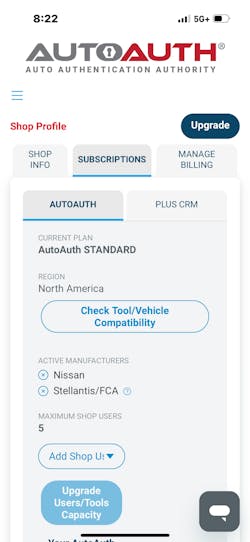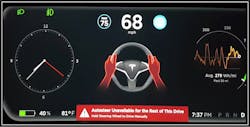As the owner/operator of a mobile diagnostic business for 33 years, I have always strived to keep on top of technology with the latest equipment as well as to keep myself educated with any new advances in the automotive industry. The only way to survive is to keep moving forward, or you will find yourself falling behind with antiquated equipment. My experience has taught me to retool my business every three years and keep all my equipment up to date with the latest software every month because our industry as a whole just moves too quickly with the advancement in technology. I just recently had to upgrade my service vehicle with a Starlink satellite dish on the roof to increase my software download services without interruption because my air card could no longer handle higher demand download speeds, and I had to overcome constant outages of cellular service. The demand for reprogramming has never been so high in my business, and I needed to keep on the cutting edge of technology (Figure 1).
Heightened network security
Over the past five years, I have seen so many new changes to enhance and improve the advanced driver assistance systems. There are so many security changes that had to be addressed to protect the onboard computer systems from being hacked by the environment around the vehicle. This all started with the introduction of the SPY Car Study Act of 2017, which set new standards for onboard cybersecurity. This involved encryption of CAN bus networks and placing a firewall system within the network to protect the powertrain and ADAS systems from entertainment systems that were tied to mobile phones or satellite services. Chrysler was one of the first manufacturers in 2018 to install a gateway computer in front of the OBD2 connector to prevent aftermarket scan tools from performing bidirectional controls without security access (Figure 2). This would soon be followed by other manufacturers as we got close to 2023 and I’m guessing that by 2025 most all manufacturers will be going this route.
Currently, Chrysler, Nissan, Mercedes, Volvo and Tesla are the manufacturers I’m seeing who have jumped on the bandwagon. The good news is that a company, AutoAuth, was launched for the aftermarket industry where you can register your shop, Wi-Fi enabled scan tools, and shop technicians to get access to unlock these vehicles (Figure 3). They will charge you a yearly fee to unlock Chrysler and Nissan vehicles for now, and I’m sure there will be many more manufacturers joining their service as time goes on. But for now, the only way to unlock the other manufacturers is with their factory scan tools with a yearly subscription that can be very costly. These networks on these vehicles have to be unlocked before you can perform any ADAS functions with your ADAS software.
There have been so many advances with the onboard ADAS software and networks, but there has also been advancement in component hardware where it’s just not about plug & play. These parts have gotten more advanced in technology and require more set up procedures prior to an ADAS calibration. They may need to be unlocked by the manufacturers, configured for the vehicle, programmed with software and even be sold as right and left pairs if their firmware has been updated. So now it’s a constant battle to keep up with the many changes. A lot of the newer radar systems have become more advanced to achieve a wider spectrum to locate multiple moving or approaching objects in front of the vehicle. So the smaller targets once used a few years ago have even tripled in size (Figure 4).
Increasingly sophisticated forward cameras
The windshield lane camera system has also reached an advancement in technology. Now, they’re not only looking for lines on the highway to keep the vehicle in the lane but are also calculating objects in the roadway to enhance the radar systems. Subaru has now moved to a mono camera system for 2024 to detect bicycles and pedestrians and coupled this with their dual EyeSight camera system (Figure 5). This now actually doubles the work needed to calibrate a windshield on a Subaru because it requires two different target setup procedures. This is all to increase the sensor fusion activity between the radar and camera system for more precise control of Level 2 ADAS vehicles where both braking and steering are involved.
Reminder: Level 2 vehicles are not autonomous
These Level 2 vehicles are able to brake, accelerate, and steer the vehicle, but they still are not driverless cars. They require the driver to be the redundancy of the system to take over the brake and gas pedals or steering wheel when necessary. Tesla will actually give you a warning on the dash after so many minutes to put your hands back on the steering wheel if it doesn’t sense your hands on the steering wheel by the use of a torque sensor within the steering system (Figure 6). If your hands do not return to the steering wheel, the system will come out of self-driving mode. Then there is always that smart person who tries to override the system by shoving two water bottles in the steering wheel as counterweights to fool the system…but this is a dangerous thing to do, so please use the vehicle as intended.
It has gotten to the point where I have already come across shops that tell me where a few customers have tried to blame their cars for the initial accident and claimed that the vehicle did not stop for them. As a precautionary measure, I had to add a disclaimer at the base of my invoice that reads as follows: “ALL camera and radar calibrations are performed to put vehicles back to specification to enhance driver assist for Level 1 and Level 2 ADAS Vehicles. These systems are NOT set up for driverless vehicles and require eyes on the road and hands on the steering wheel at ALL times. Drivers must ALWAYS be prepared for a handoff of vehicle operations such as steering and braking at ANY given moment.” This is a disclaimer that you should also be putting on your invoices to protect yourself when performing ADAS calibrations.
There are Level 3 vehicles out there where the vehicle will actually drive itself, but there is still a redundancy requirement to take over operations if the vehicle has issues to maintain its task of driving the vehicle for you. This driverless technology is just getting more advanced as time goes on, but we still have a way to go. I see the future with more advanced ADAS components becoming standard in the vehicles as they become more cheaper to install, such as night vision using thermal cameras because they can do a more precise recognition of pedestrians and bicycles in the roadway then standard camera and radar systems. Then you also have the 3D area mapping using lidar laser light technology that can’t be fooled by shadows, bright sunlight, or oncoming headlights that camera systems are exposed to.
Taking driverless vehicles to the next level
The final stage to take driverless vehicles to the next level would be to build an advanced roadway infrastructure to interact with ADAS vehicles. This would include smart signal lights that could warn vehicles of the status of their operation prior to reaching an intersection or even a roadside unit to warn vehicles about accidents and road conditions. This could even be coupled with Vehicle2Vehicle communications (Figure 8). The possibility of these things happening is not too farfetched, but just be prepared when we get there. So, keep tooling and keep current on the latest technologies. Don’t fall behind, or technology will pass you up.
About the Author

John Anello
Owner and operator of Auto Tech on Wheels
John Anello is the owner and operator of Auto Tech on Wheels, established in 1991 in northern New Jersey. He provides technical assistance and remote reprogramming with 21 factory PC-based scan tools. Driven by a passion for cars, John's business now services roughly 1,700 shops.








